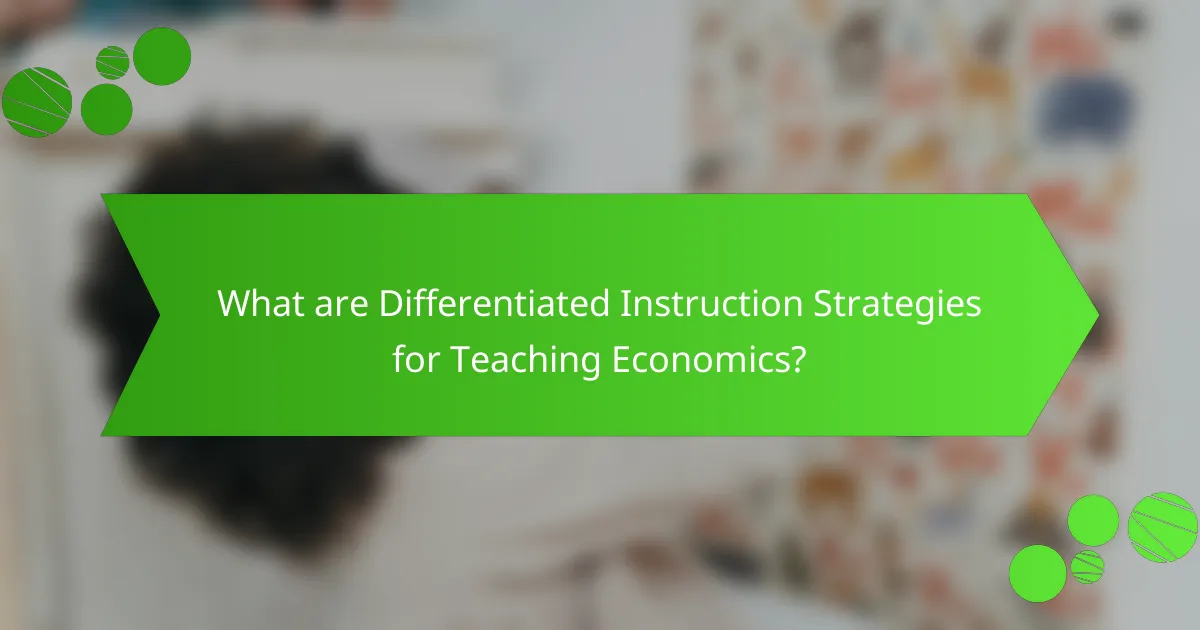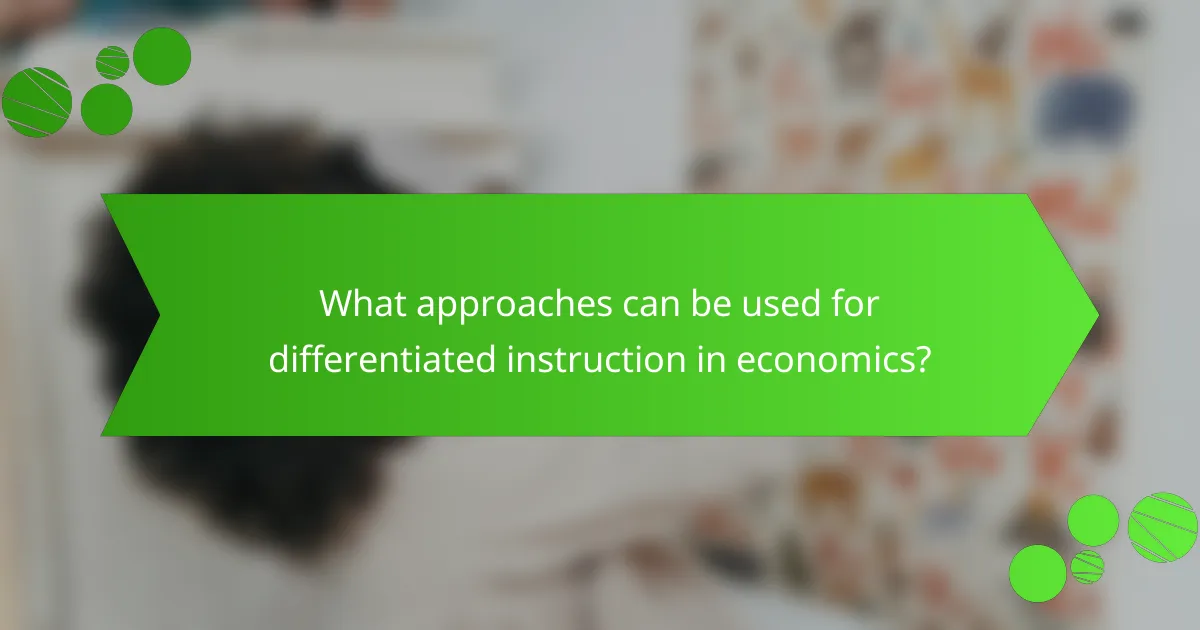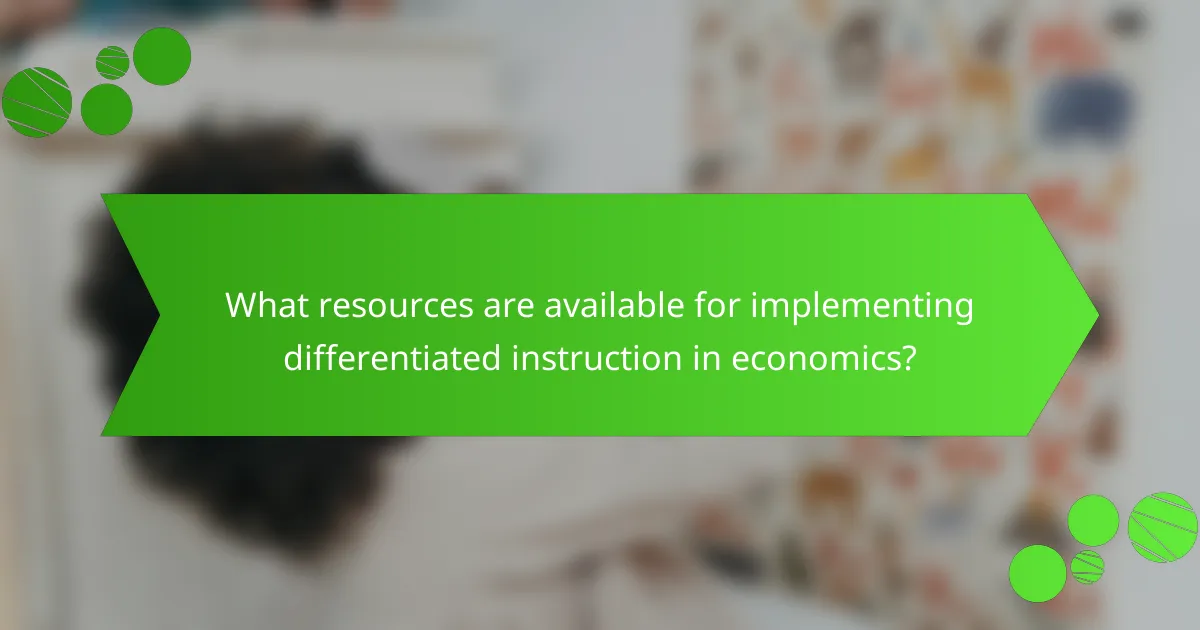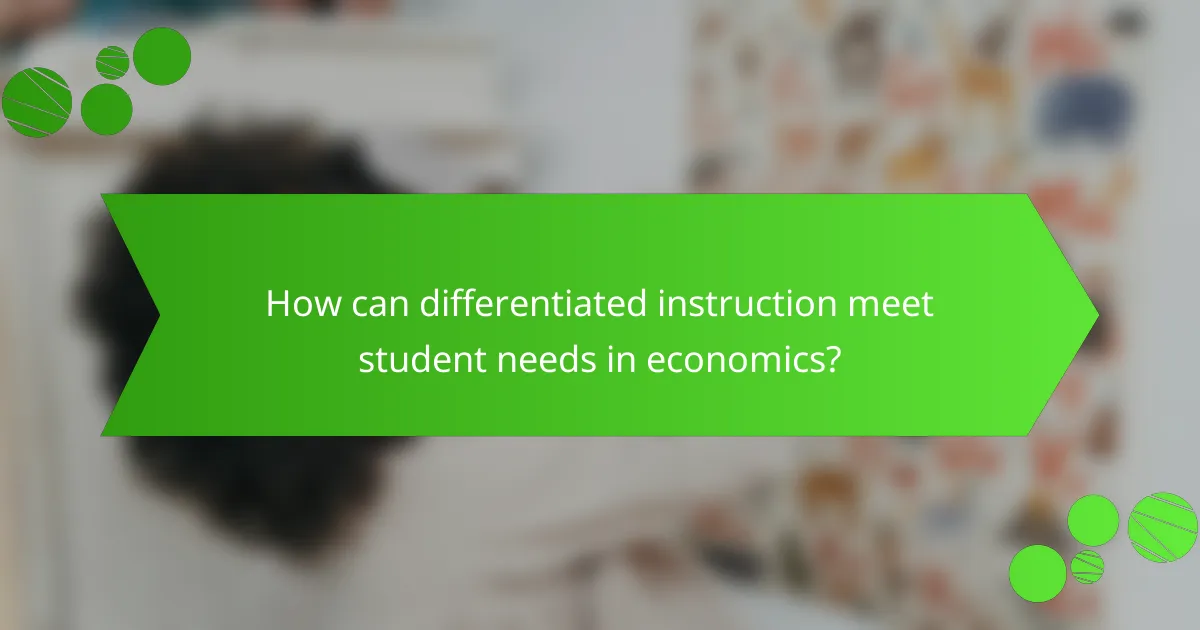Differentiated instruction strategies for teaching economics focus on adapting educational methods to meet the diverse learning needs of students. Key strategies include flexible grouping, tiered assignments, and the use of real-world applications to enhance comprehension. Additionally, technology integration, such as interactive simulations, and offering choices in assignments cater to various interests and learning styles. Ongoing assessments play a crucial role in informing instruction and tailoring support to individual student needs. Resources for effective implementation encompass teaching materials, digital platforms, and professional development opportunities that equip educators to address the varied requirements in economics education.

What are Differentiated Instruction Strategies for Teaching Economics?
Differentiated instruction strategies for teaching economics include varied teaching methods tailored to students’ diverse learning needs. These strategies may involve flexible grouping, where students collaborate in different groups based on their skill levels. Another approach is tiered assignments, which provide tasks at varying difficulty levels to match students’ understanding. Additionally, incorporating real-world applications helps students relate economic concepts to their daily lives. Utilizing technology, such as interactive simulations, can engage students and enhance comprehension. Providing choices in assignments allows students to select tasks that align with their interests. Lastly, ongoing assessment informs instruction and helps educators adjust strategies to meet individual student needs.
How do differentiated instruction strategies enhance learning in economics?
Differentiated instruction strategies enhance learning in economics by addressing diverse student needs and learning styles. These strategies allow educators to tailor lessons to individual student strengths and weaknesses. For instance, using varied instructional methods—such as visual aids, group discussions, and hands-on activities—can engage students more effectively. Research shows that when students receive instruction that aligns with their preferred learning styles, they are more likely to retain information. A study published in the “Journal of Economic Education” found that differentiated approaches improve student comprehension and interest in economic concepts. By providing multiple pathways for learning, differentiated instruction fosters a deeper understanding of economics among students.
What key principles underlie differentiated instruction in economics education?
Differentiated instruction in economics education is grounded in several key principles. These principles include recognizing student variability, aligning instruction with learning goals, and providing multiple means of engagement. Recognizing student variability involves understanding diverse learning styles and readiness levels. Aligning instruction with learning goals ensures that all students work towards the same educational objectives. Providing multiple means of engagement motivates students by offering choices in how they learn. Research indicates that differentiated instruction can enhance student achievement and engagement in economics courses. Studies show that tailoring instruction to meet individual needs leads to improved understanding of economic concepts.
How do student diversity and learning styles influence differentiated instruction?
Student diversity and learning styles significantly influence differentiated instruction. Diverse student backgrounds contribute to varying perspectives and experiences. This diversity requires educators to tailor their teaching methods. Learning styles, such as visual, auditory, and kinesthetic, further complicate instructional approaches. Research indicates that students learn best when instruction aligns with their preferred learning styles. For instance, a study by Tomlinson (2001) emphasizes the importance of adapting lessons to meet individual needs. By recognizing these differences, teachers can enhance engagement and comprehension. Differentiated instruction thus becomes essential for effective teaching in diverse classrooms.
Why is it important to implement differentiated instruction in economics?
Implementing differentiated instruction in economics is crucial to address diverse learning needs. Students possess varying backgrounds, interests, and abilities. Differentiated instruction allows educators to tailor lessons to these differences. This approach enhances engagement and understanding of economic concepts. Research shows that differentiated instruction improves student performance. A study by Tomlinson (2001) highlights that tailored teaching methods lead to higher achievement rates. Thus, implementing differentiated instruction in economics fosters an inclusive learning environment. It ensures all students can grasp complex economic theories effectively.
What are the potential outcomes of using differentiated strategies in economics classes?
Using differentiated strategies in economics classes can lead to improved student engagement and understanding. These strategies cater to diverse learning styles and abilities. Tailored instruction helps students grasp complex economic concepts more effectively. Research shows that differentiated instruction can enhance academic performance. For instance, a study by Tomlinson (2014) found that students in differentiated classrooms demonstrate higher levels of motivation. Additionally, differentiated strategies foster a collaborative learning environment. This approach encourages peer interaction and support. Ultimately, these outcomes contribute to a more inclusive and effective learning experience in economics education.
How can differentiated instruction address varying student needs in economics?
Differentiated instruction can effectively address varying student needs in economics by tailoring teaching methods to individual learning styles and readiness levels. This approach allows educators to provide diverse instructional strategies, such as visual aids, hands-on activities, and technology integration. For instance, some students may benefit from graphical representations of economic concepts, while others might prefer interactive simulations.
Research indicates that differentiated instruction can enhance student engagement and understanding. A study by Tomlinson (2014) found that when teachers adjust their methods based on student interests and abilities, academic performance improves. Furthermore, differentiated assessments can help educators gauge student comprehension and adapt lessons accordingly.
Overall, by recognizing and responding to the unique needs of students, differentiated instruction fosters a more inclusive and effective learning environment in economics.

What approaches can be used for differentiated instruction in economics?
Differentiated instruction in economics can be approached through various strategies. One effective method is tiered assignments. This allows students to work at different levels of complexity based on their readiness. Another approach is flexible grouping. This involves grouping students by shared interest or ability for specific tasks. Additionally, learning centers can provide diverse activities tailored to various learning styles. Use of real-world applications can also enhance understanding. This connects economic concepts to students’ lives. Finally, ongoing assessments can inform instruction and help tailor support to individual needs. These methods ensure that all students engage with the material effectively.
How can teachers assess student readiness for differentiated instruction?
Teachers can assess student readiness for differentiated instruction through various methods. These methods include pre-assessments, which evaluate students’ prior knowledge and skills. Teachers can use formative assessments during lessons to gauge ongoing understanding. Observations of student engagement and participation provide insight into readiness levels. Additionally, student self-assessments encourage reflection on their own learning. Utilizing learning profiles helps tailor instruction to individual needs. Research indicates that effective assessment can lead to improved student outcomes. For example, a study by Tomlinson (2014) highlights the importance of understanding student readiness for effective differentiation.
What tools and methods can be used for assessing student readiness?
Tools and methods for assessing student readiness include formative assessments, surveys, and diagnostic tests. Formative assessments, such as quizzes and class discussions, provide ongoing feedback on student understanding. Surveys can gauge students’ prior knowledge and learning preferences. Diagnostic tests help identify specific skill gaps before instruction begins. These methods allow educators to tailor their teaching strategies effectively. Research shows that using a combination of these tools leads to better alignment of instruction with student needs. For example, a study by Black and Wiliam (1998) highlights the positive impact of formative assessment on student achievement.
How does assessment inform the differentiation process in economics teaching?
Assessment informs the differentiation process in economics teaching by identifying students’ varying levels of understanding. It allows educators to tailor instruction based on individual needs. Through formative assessments, teachers can gauge student comprehension in real-time. Summative assessments provide insights into overall learning outcomes. This data helps in grouping students according to their proficiency. Differentiation can then occur in content, process, and product. For example, advanced learners might engage in more complex economic theories. Struggling students may receive additional support and resources. Research indicates that effective assessment practices lead to improved student performance and engagement in economics.
What types of differentiated instruction approaches are effective in economics?
Effective differentiated instruction approaches in economics include tiered assignments, learning contracts, and flexible grouping. Tiered assignments allow students to work at varying levels of difficulty on the same topic. This approach ensures that all students engage with the material while accommodating their individual readiness levels. Learning contracts provide students with choices regarding how they will learn and demonstrate understanding. This method fosters autonomy and personal investment in their education. Flexible grouping enables teachers to form dynamic groups based on students’ needs and skills, promoting collaboration and peer learning. Research shows that these methods can enhance student engagement and understanding in economics, as they address diverse learning styles and preferences.
What are the various models of differentiated instruction applicable to economics?
The various models of differentiated instruction applicable to economics include the Tomlinson Model, the Tiered Instruction Model, and the Learning Profile Model. The Tomlinson Model emphasizes adjusting content, process, and products based on student readiness, interest, and learning profile. This model allows teachers to provide varied assignments that engage students at different levels of understanding. The Tiered Instruction Model involves designing lessons with varying levels of complexity. This approach ensures that all students are challenged appropriately, regardless of their skill levels. The Learning Profile Model focuses on tailoring instruction to match students’ preferred learning styles and interests. Research shows that differentiated instruction can enhance student engagement and achievement in economics.
How can tiered assignments be effectively utilized in economics education?
Tiered assignments can be effectively utilized in economics education by providing students with varied tasks that align with their individual learning levels. This approach allows educators to meet diverse student needs while covering the same essential economic concepts. For instance, basic tasks may involve simple definitions of economic terms, while advanced assignments could require analysis of economic theories.
Research shows that tiered assignments promote engagement and understanding among students with different abilities. A study by Tomlinson (2001) emphasizes that differentiated instruction, including tiered assignments, enhances student motivation and achievement. By adjusting the complexity of tasks, educators can ensure that all students are challenged appropriately, fostering a deeper understanding of economics.

What resources are available for implementing differentiated instruction in economics?
Resources for implementing differentiated instruction in economics include various teaching materials, strategies, and professional development opportunities. Textbooks and online resources provide diverse content tailored to different learning styles. Digital platforms like Khan Academy and Coursera offer interactive courses on economics. Teaching tools such as graphic organizers and concept maps help visualize complex ideas. Professional development workshops focus on differentiated instruction techniques. Collaborative learning activities encourage peer-to-peer teaching and engagement. Assessment tools allow for varied evaluation methods to accommodate different student needs. These resources support educators in effectively meeting the diverse learning requirements in economics classrooms.
What teaching materials support differentiated instruction in economics?
Teaching materials that support differentiated instruction in economics include various resources tailored to diverse learning styles. These materials encompass textbooks with varied reading levels, visual aids like charts and graphs, and interactive simulations. Additionally, case studies provide real-world applications, while multimedia resources such as videos enhance engagement. Online platforms offer personalized learning paths and assessments. Research indicates that diverse materials cater to individual student needs, improving comprehension and retention. For instance, a study by Tomlinson (2001) emphasizes the effectiveness of varied instructional strategies in fostering student success in economics.
How can digital resources enhance differentiated instruction in economics?
Digital resources enhance differentiated instruction in economics by providing varied learning materials tailored to diverse student needs. These resources include interactive simulations, videos, and online assessments. They allow students to engage with economic concepts at their own pace. For instance, platforms like Khan Academy offer personalized learning paths. This adaptability caters to different learning styles, such as visual or auditory. Furthermore, digital tools enable teachers to track student progress and adjust instruction accordingly. Research indicates that technology integration can improve student engagement and understanding of complex economic theories.
What role do textbooks and supplementary materials play in differentiation?
Textbooks and supplementary materials are essential tools for differentiation in education. They provide diverse content that caters to varied learning styles and levels. Textbooks offer foundational knowledge, while supplementary materials enhance understanding through varied perspectives. These resources allow educators to tailor instruction to meet individual student needs. For example, visual aids can support visual learners, while interactive activities engage kinesthetic learners. Research indicates that differentiated resources improve student engagement and achievement. Consequently, textbooks and supplementary materials play a crucial role in creating an inclusive learning environment.
Where can teachers find professional development resources for differentiated instruction?
Teachers can find professional development resources for differentiated instruction through various platforms. Online websites such as ASCD and Edutopia offer a wealth of articles and courses. The International Society for Technology in Education (ISTE) provides specific resources for technology integration in differentiated learning. Local education agencies often host workshops focused on differentiated instruction strategies. Universities and colleges may also offer courses or certifications in this area. Additionally, professional organizations like the National Council for Teachers of Mathematics provide resources tailored to specific subjects. Research studies, such as those published in the Journal of Educational Psychology, highlight effective practices in differentiated instruction. These resources collectively support teachers in enhancing their instructional strategies.
What online courses and workshops are available for educators in economics?
Online courses and workshops for educators in economics include offerings from various institutions. The National Council on Economic Education provides online courses focused on economics pedagogy. The Council for Economic Education also offers professional development workshops. Additionally, platforms like Coursera and edX feature courses from universities on economic theories and teaching methods. These resources aim to enhance educators’ skills in delivering economics content effectively.
How can collaboration with colleagues enhance differentiated instruction practices?
Collaboration with colleagues enhances differentiated instruction practices by fostering shared expertise and diverse perspectives. When educators work together, they can develop tailored strategies that address varied student needs. This collaboration promotes the exchange of resources, such as lesson plans and assessment tools. Research indicates that teacher collaboration leads to improved student outcomes. A study by Vescio, Ross, and Adams (2008) found that collaborative professional development positively impacts instructional practices. This collaborative environment encourages innovation and adaptability in teaching methods. Ultimately, enhanced differentiation results in more effective learning experiences for all students.

How can differentiated instruction meet student needs in economics?
Differentiated instruction can meet student needs in economics by tailoring teaching methods to diverse learning styles. This approach allows educators to modify content, process, and assessments based on individual student readiness and interests. For example, visual learners may benefit from graphs and charts, while auditory learners may excel with discussions and lectures. Research shows that differentiated instruction can lead to improved student engagement and understanding. A study by Tomlinson (2001) indicates that students in differentiated classrooms demonstrate higher academic achievement. Thus, differentiated instruction effectively addresses varying student needs in economics education.
What specific student needs should be addressed through differentiated instruction?
Specific student needs addressed through differentiated instruction include varying learning styles, readiness levels, and interests. Learning styles refer to how students prefer to receive and process information. Readiness levels indicate the current understanding and skills of each student. Interests encompass topics or themes that engage students and motivate them to learn.
Differentiated instruction aims to meet these diverse needs effectively. For example, visual learners may benefit from graphic organizers. Advanced students might require more challenging tasks to stay engaged. Students with specific interests can be provided with relevant materials to foster deeper understanding.
Research shows that tailoring instruction to student needs enhances engagement and achievement. According to Tomlinson (2001), differentiated instruction can significantly improve student outcomes by addressing their unique learning requirements.
How can teachers identify and respond to diverse student needs in economics?
Teachers can identify and respond to diverse student needs in economics by utilizing formative assessments. These assessments can include quizzes, surveys, and observation techniques to gauge understanding. Teachers should analyze student performance data to identify learning gaps. Tailoring instruction based on these insights allows for differentiated learning experiences.
Implementing varied instructional strategies, such as group work and individualized tasks, addresses different learning styles. Providing multiple resources, like videos and articles, supports diverse learners. Additionally, fostering an inclusive classroom environment encourages student participation. Educators can also engage in regular feedback sessions to adapt teaching methods effectively.
Research indicates that differentiated instruction can enhance student engagement and achievement in economics (Tomlinson, 2017).
What strategies can be used to engage and motivate all learners in economics?
To engage and motivate all learners in economics, educators should employ a variety of differentiated instruction strategies. These strategies include incorporating real-world applications of economic concepts. For example, case studies can illustrate how economic theories apply to current events. Interactive simulations, such as market role-plays, can make learning dynamic and engaging.
Additionally, using technology, like economic games or online platforms, can enhance student interest. Group projects allow for collaboration, catering to diverse learning styles. Visual aids, such as infographics and videos, can help clarify complex topics.
Regular formative assessments can provide feedback and adjust teaching methods to meet learner needs. According to a study by Tomlinson (2001), differentiated instruction improves student engagement and motivation. These strategies create a more inclusive and effective learning environment in economics.
What best practices can teachers adopt for effective differentiated instruction in economics?
Teachers can adopt several best practices for effective differentiated instruction in economics. First, they should assess students’ prior knowledge and learning styles. This allows teachers to tailor their instruction accordingly. Second, using flexible grouping strategies is essential. Grouping students by interest or ability fosters collaboration and peer learning. Third, providing varied instructional materials enhances engagement. Resources like videos, articles, and simulations cater to diverse learning preferences. Fourth, offering choices in assignments empowers students. Allowing them to select topics or formats can increase motivation. Fifth, implementing formative assessments regularly helps track progress. This data guides instructional adjustments. Lastly, fostering a supportive classroom environment encourages risk-taking and open dialogue. Research indicates that these practices lead to improved student outcomes in economics education.
How can teachers create a supportive classroom environment for differentiation?
Teachers can create a supportive classroom environment for differentiation by fostering an inclusive atmosphere. This involves recognizing diverse learning styles and needs among students. Teachers can implement flexible grouping strategies to encourage collaboration. They should also provide varied instructional methods, such as visual aids and hands-on activities. Regular feedback helps students understand their progress and areas for improvement. Establishing clear expectations and routines promotes a sense of security. Additionally, teachers can build strong relationships with students to enhance engagement. Research shows that supportive environments lead to better academic outcomes and increased student motivation.
What are common challenges teachers face in implementing differentiated instruction?
Common challenges teachers face in implementing differentiated instruction include lack of time, resources, and training. Teachers often struggle to develop tailored lesson plans for diverse student needs. Limited access to appropriate materials hinders effective differentiation. Classroom management becomes complex with varied instructional strategies. Assessment methods may not align with differentiated approaches. Teachers also face pressure to cover standardized curriculum requirements. Collaboration among staff can be difficult, impacting shared strategies. These challenges can lead to inconsistent implementation of differentiated instruction.
Differentiated Instruction Strategies for Teaching Economics focus on tailored teaching methods designed to meet the diverse learning needs of students. The article outlines various strategies, including flexible grouping, tiered assignments, and real-world applications, that enhance student engagement and comprehension. Key principles of differentiated instruction, such as recognizing student variability and aligning instruction with learning goals, are discussed alongside the importance of assessing student readiness. Additionally, the article highlights effective approaches, resources, and best practices for implementing differentiated instruction in economics classrooms to foster an inclusive learning environment.



